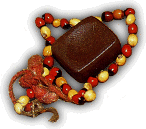
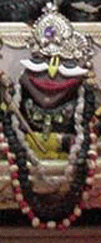

Gunja malas or Kunrimani mala
last updated 22nd May 2013



The Danger Associated with Gunja-malas
(A must read in conjunction with keeping the sacredness of Gunja malas)
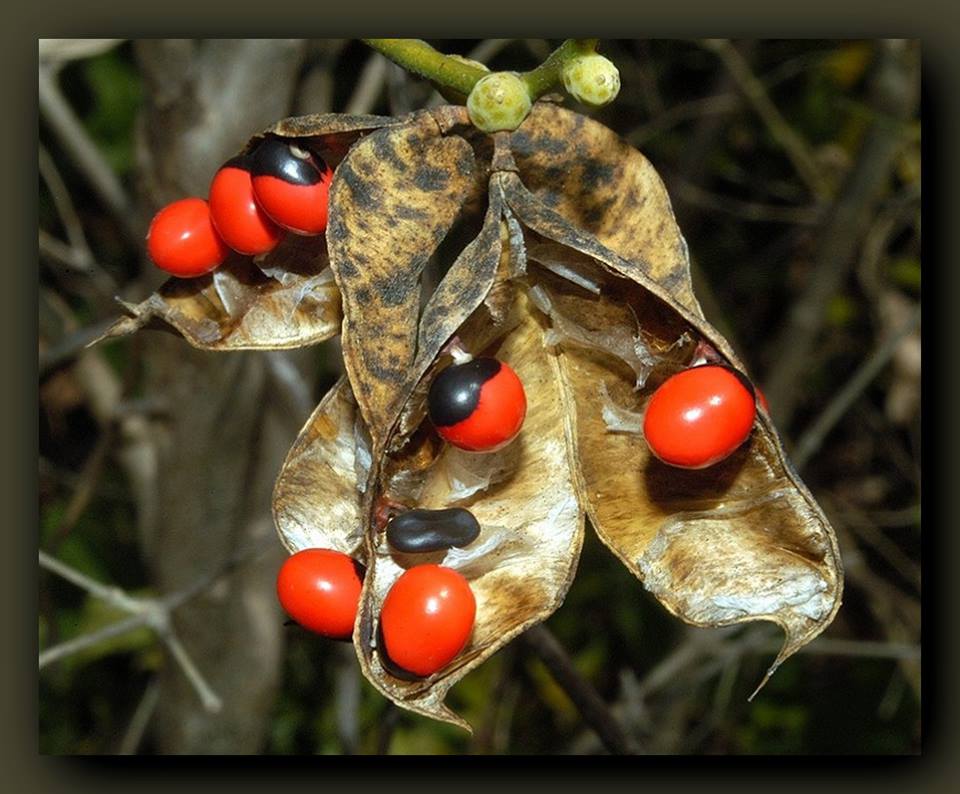
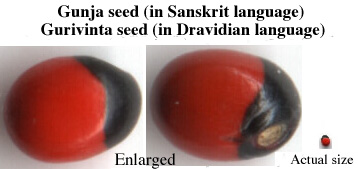
What is Gunja Seed?
Ratti Measure Unit - Gunchi, Gunja Seed or Ratti Seed A high-climbing, twining, or trailing woody vine with alternately compound leaves, indigenous to India. Leaves alternate, 5-13 cm long, even-pinnately compound with 5-15 pairs of leaflets, these oval to oblong, to 1.8 cm long, with margins entire.
The flowers, shaped like pea flowers, are small, pale, violet to pink and arranged in clusters. Fruit a short, oblong pod, splitting before falling to reveal 3-8 shiny hard seeds, 6-7 mm long, scarlet with black bases. The seeds of abrus precatorius are much valued in native jewelry for their bright coloration. The third of the bean with the hilum (attachment scar) is black, while the rest is bright red, suggesting a ladybug.
Jewelry-making with jequirity seeds is dangerous, and there have been cases of death by a finger-prick while boring the seeds for beadwork. The seeds were traditionally used to weigh jewelry in India. The measure ratti is equal to the weight of one seed.
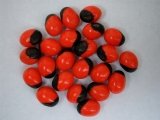
Gunja Seed: Common name: Coral bead vine, Rosary pea, Gunchi (Hindi),
Gunjaa (Sanskrit), Gulugunji (Kannada), Gunch (Bengali), Ratti (Gujarati),
kundu maNi (Tamil), Gunja (Marathi)
Botanical name: Abrus precatorius Family: Fabaceae
(pea family)
gunjä—berry necklace; madhurä—sweet; mälä—garland; madhurä—sweet; yamunä—the river; madhurä—sweet; vici—ripples; madhurä—sweet; salilam—water; madhuram—sweet; kamalam—lotuses; madhuram—sweet; madhura-adhi-pateh—of the Emperor of sweetness; akhilam—all; madhuram—sweet.
"His Gunja necklace is sweet, as is His garland.
His Yamuna River is sweet, her waves are sweet,
and her waters are sweet. The lotus flowers are also sweet.
Everything is completely sweet about the Supreme Personality of Godhead,
the Lord of sweetness."
(Srila Vallabhacharya. Madhuraashtakam 6.)
våndävanera sampad dekha,—puñpa-kisalaya
giridhätu-çikhipiccha-guïjäphala-maya
SYNONYMS
våndävanera—of Våndävana;
sampad—the opulence; dekha—see; puñpa-kisalaya—a few flowers and
twigs; giri-dhätu—some minerals from the hills; çikhi-piccha—some
peacock feathers; guïjä-phala-maya—some guïjä-phala.
TRANSLATION
“As far as Våndävana’s
opulence is concerned, it consists of a few flowers and twigs, some minerals
from the hills, a few peacock feathers and the plant known as guïjä.
(Sri Chaitanya Charitamrita Madhya-lila 14:204.)
In the age of Kali, His merciful incarnation, Lord Gaurasundara also initiated and induced His confidential associates to perform the worship of Govardhana. Once, Sri Sankarananda Sarasvati came to Puri dhama from Sri Vrndavana to deliver to Sriman Mahaprabhu a piece of the Govardhana stone together with a string of 'gunja mala' (beads) wrapped in two bundles of cloth which he presented to Sriman Mahaprabhu who, at that time was residing at Gambhira. The Lord became exceedingly pleased on receiving these invaluable items. In continuous remembrance of the divine pastimes of Sri Radha-Krsna, He used to wear the mala (beads) round His neck. By contemplation of the Govardhana stone as non-different form the transcendental body of Sri Krishna, He used to place this stone over His head and eyes, becoming overwrought with loving emotions. In the loving moods, He would exuberantly place it on His head or near His nose as if to catch the overpowering transcendental fragrances of the stone and more often than no, would drench it with tears flowing form His eyes. In this regard, Sriman Mahaprabhu used to visualize the Govardhana stone and the gunja mala together as the personification of the Divine Couple Sri Radha-Krishna. He, in this manner conducting worship of the Govardhana stone for a succession of three consecutive years, later handed it over to His most affectionate associate Sri Raghunatha as Goswami speaking;
prabhu hake ei 'sila krsnera vigraha
ihara seva kara tumi kariya agraha
ei silara kara tumi sattvika pujana
achirat pabe tumi-krsna-prema-dhana
Sriman Mahaprabhu instructed: "The method of worshipping the Govardhana stone is very simple. Simply bathe the stone by using a pot of water together with eight Tulasi manjaris which is to be offered with devotion to the Govardhana stone on both sides." {a Tulasi manjari is contained between two Tulasi leaves}
The great soul Sri Raghunatha, having obtained these priceless items from the hands of Sriman Mahaprabhu Himself, realizing His internal moods by His mercy began to engage in the service of the Govardhana stone with great devotion. In worship, he placed on the feet of the stone, the gunja beads which were the representation of Srimati Radhika. His bliss in his devotional service knew no limit. His only ingredients for worship was one water pot for collecting water, two pieces of cloth each the measure of half an arm length and a small wooden pedestal. He, by this type of devoted worship, began to actually perceive the pure form of Sri Krishna-Vrajendra-nandana- during the course of worship and meditation. Srila Krsna Das Kaviraja writes:
jala tulasira sevaya sukhodaya
sadasopacara pujaya tata sukha naya
His joy that he experienced in worship was beyond comparison, more so that what one could possibly attain by using all the sixteen articles to worship in a grand way. The Lord who is naturally affectionate to His devotees becomes completely subjugated by pure devotional service only. In Vishnu-dharma, there is mention of how the Lord can be brought over by in devotional service. In this context, how Sri Advaita Acarya was able to move the Supreme Lord to hear his plea is given:
tulasi dala matrena jalasya culukena va
vikrinite svamatamanam bhaktyebhyo bhakta vatslah
Lord Krishna, being overcome by the spontaneous affection of His devotee, becomes bought by such devotees in the course of offering Tulasi leaves and a handful of water. In Caitanya Caritamrta it mentions:
krsnake tulasi jala deya yei jana
tara rna sodhite krsna karen chintan
Sri Advaita Acarya began to reflect that the faithful devotee, in simply offering some handful of water and Tulasi leaves to the Supreme Lord in pure devotion, will result in Sri Krishna not being able to free Himself from His great debt to such a pure devotee. Therefore, only by the Supreme Lord manifesting His original form, will He be able to give up His debt.
Therefore Advaita Acarya, in order to make Sri Krishna appear in His original form began to offer with great devotion, some holy Ganga water and a few Tulasi manjaris. The inaugurator of religious principles, Sri Krishna appeared to exhibit the magnanimous pastimes of Lord Caitanya in order to distribute love of Godhead and to fulfill the prayers of His great devotee Sri Advaita Acarya. In the Srimad Bhagavatam, the world teacher Lord Brahma glorifies the Lord in this way:-
tvam bhakti-yoga-paribhavita-hrt-saroja
asase sruteksita-patho nanu natha pumsam
yas-yad-dhiya ta urugaya vibhavayanti
tad-tad-vapuh pranayase sad-anugrahaya
(3/9/11)
"Oh Lord! The means of obtaining You by devotional service becomes available
through oral reception of the messages and instructions of the spiritual
master. You are present in the heart of Your devotees who have become purified
by devotional service to You. The devotees in this way worship You with
their individual natures while You, by Your causeless mercy, reciprocate
with them in that very form of their meditations. ('srute ksitapato'- one
who, after hearing from Sri Guru and later by initiation, embarks on devotional
service- Srila Visvanatha Thakura). Consequently, Srila Raghunatha Das
Goswami was exemplary in his method of worshipping Giri Govardhana with
pure devotion.(http://www.bvml.org/SBPPG/eopd7.htm)
"Sri Caitanya Mahäprabhu entrusted Raghunätha däsa Gosvämi to Svarüpa Dämodara Gosvämi. Therefore another name for Raghunätha däsa Gosvämi is Svarüpera Raghu, or the Raghunätha of Svarüpa Dämodara. For five days Raghunätha däsa Gosvämi took prasädam at the temple, but later he would stand at the Simha-dvära gate and eat only whatever he could gather by alms. Later he lived by taking alms from various chatras, or food distributing centers. When Raghunätha’s father received news of this, he sent some men and money, but Raghunätha däsa Gosvämi refused to accept the money. Understanding that Raghunätha däsa Gosvämi was living by begging from the chatras, Sri Chaitanya Mahäprabhu presented him with His own guïjä-mälä and a stone from Govardhana Hill." (Sri Chaitanya Charitamrita, Antya-lila chapter 6 summary to chapter excerpt.)
Did Srila A.C. Bhaktivedanta Swami make a mistake in saying Gunja mala are small conchshells as he does all through Chaitanya Charitamrita, or was it intentional? It would appear that it was an intentional statement from the following conversation excerpt:
Prabhupäda: Hare Kåñëa.
[break] ...garland, this girl. Garland just like beads.
Satsvarüpa: Make a garland
out of stone?
Prabhupäda: Yes. Not stone.
Satsvarüpa: Shells.
Prabhupäda: They are conch
shells, small conchshells. They are called gunja, gunja. They are called
gunja? [break]
(Srila A. C. Bhaktivedanta Swami
Prabhupad. 1st April 1974. Morning walk. Bombay.)
From this time on any reference to Gunja or Gunja mala was written as small conchshells.
eta bali’ täìre punaù prasäda
karilä
’govardhanera çilä’, ‘guïjä-mälä’
täìre dilä
SYNONYMS
eta bali’—saying this; täìre—unto
him; punaù—again; prasäda karilä—gave something in mercy;
govardhanera çilä—a stone from Govardhana Hill; guïjä-mälä—a
garland of small conchshells; täìre dilä—delivered to
him.
TRANSLATION
After saying this, Çré Caitanya
Mahäprabhu again bestowed His mercy upon Raghunätha däsa
by giving him a stone from Govardhana Hill and a garland of small conchshells.
“çilä diyä gosäïi samarpilä
‘govardhane’
guïjä-mälä diyä dilä
‘rädhikä-caraëe’”
SYNONYMS
çilä diyä—by offering this stone;
gosäïi—Çré Caitanya Mahäprabhu; samarpilä—offered;
govardhane—a place near Govardhana Hill; guïjä-mälä
diyä—by offering the garland of small conchshells; dilä—offered;
rädhikä-caraëe—shelter at the lotus feet of Çrématé
Rädhäräëé.
TRANSLATION
“By offering me the govardhana-çilä,
Çré Caitanya Mahäprabhu has offered me a place near
Govardhana Hill, and by offering me the garland of conchshells, He has
offered me shelter at the lotus feet of Çrématé Rädhäräëé.”(CC
Antya 6:307)
çré-brahmoväca
nauméòya te 'bhra-vapuñe
taòid-ambaräya
guïjävataàsa-paripiccha-lasan-mukhäya
vanya-sraje kavala-vetra-viñäëa-veëu-
lakñma-çriye mådu-pade
paçupäìgajäya
SYNONYMS
çré-brahmä uväca—Lord
Brahmä said; naumi—I offer praise; éòya—O most worshipable
one; te—unto You; abhra—like a dark cloud; vapuñe—whose body; taòit—like
lightning; ambaräya—whose garment; guïjä—made of small
berries; avataàsa—with ornaments (for the ears); paripiccha—and
peacock feathers; lasat—resplendent; mukhäya-whose face; vanya-sraje—wearing
garlands of forest flowers; kavala—a morsel of food; vetra—a stick; viñäëa—a
buffalo-horn bugle; veëu—and a flute; lakñma—characterized
by; çriye—whose beauty; mådu—soft; pade—whose feet; paçu-pa—of
the cowherd (Nanda Mahäräja); aìga-jäya—unto the
son.
TRANSLATION
Lord Brahmä said: My dear Lord,
You are the only worshipable Lord, the Supreme Personality of Godhead,
and therefore I offer my humble obeisances and prayers just to please You.
O son of the king of the cowherds, Your transcendental body is dark blue
like a new cloud, Your garment is brilliant like lightning, and the beauty
of Your face is enhanced by Your guïjä earrings and the peacock
feather on Your head. Wearing garlands of various forest flowers and leaves,
and equipped with a herding stick, a buffalo horn and a flute, You stand
beautifully with a morsel of food in Your hand. (Srimad Bhagavatam.10:14:.
translation of Hrydayananda dasa Goswami)
çyämasundara, çikhipiccha-guïjä-vibhüñaëa
gopa-veça, tri-bhaìgima,
muralé-vadana
agre vékñya çikhaëòa-khaëòam
aciräd utkampam älambate
guïjänäà ca
vilokanän muhur asau säsraà parikroçati
no jäne janayann apürva-naöana-kréòä-camatkäritäà
bäläyäù kila
citta-bhümim aviçat ko 'yaà navéna-grahaù
mahä-sampad-däväd
api patitam uddhåtya kåpayä
svarüpe yaù svéye
kujanam api mäà nyasya muditaù
uro-guïjä-häraà
priyam api ca govardhana-çiläà
dadau me gauräìgo hådaya
udayan mäà madayati
räsa-sthaléra välu
ära govardhanera çilä
çuñka pakka pélu-phala
ära guïjä-mälä
çikhaëdair guëjäbhir
vidhasu manobhiù kiçalayaiù
kåtä kalpo‘nalpair mudita
hådayo nanda tanayaù
vicikréòa svairaà
sama-guëa-vayoveça lalitair
balädyair gopälaiù
saha sahacaraiù kelivipine
“O Çréniväsa, know for certain that only by the grace of Raghunätha däsa Gosvämé can one live at Rädhä-kuëòa. Raghunätha's service to Rädhä-kuëòa, the govardhana-çilä, and the guïjä-mälä is very famous. [One may refer to Caitanya-caritämåta, Antya-lélä 6.287-307. Guïjä is a small bright red and black seed of the guïjä creeper found in Vraja.] (Bhakti-ratnakara - Pundarik Vidyanidhi. "Living in Rädhä-kuëòa Only by the Grace of Çréla Däsa Gosvämé") (courtesy of http://www.vedabase.com)
kñipraà svasyänujasyäpi
sammärjya vadanämbujam
vastrodaräntare vaàçéà
çåìga-vetre
ca hastayoù
kaëöhe kadamba-mäläà
ca
barhäpéòaà
ca mürdhani
navaà guïjävataàsaà
ca
karëayor nidadhe çanaiù
racayitvä vanya-veçaà
tvañöå-kalpita-vastubhiù
baläd utthäpayan dhåtvä-
bravéd uccatara-svaraiù
SYNONYMS
racayitvä—arranging; vanya—of
the forest; veçam—an outfit; tvañöå—by Viçvakarmä;
kalpita—produced; vastubhiù—with items; balät—by physical effort;
utthäpayan—raising Him; dhåtvä—taking hold; äbravét—addressed;
ucca-tara—very loud; svaraiù—in a voice.
TRANSLATION
Thus having arranged a forest outfit
for Kåñëa with items made by Viçvakarmä,
Balaräma with some effort lifted Kåñëa and then
spoke to Him loudly.
COMMENTARY
While dressing Kåñëa
for the forest, Balaräma also dressed Himself. The special items required
were native to Vraja and unavailable in Dvärakä, but Viçvakarmä,
who had at his disposal all the creative skills of the demigods, had made
convincing substitutes for real kadamba flowers, guïjä berries,
and so on. (Srila Sanatan Goswami. Brihad-bhagavatamrita. 1:7:21.)
The Sri Vaishnavas echoe the same; in Gopala Vimsati - Verse 17 translated by V. Sadagopan
from http://www.ramanuja.org/sv/acharyas/desika/stotras/gopalavimsati.html
citrAkalpa: Sravasi kalayan lankalI
karNapUram.
barhottamsa sphuritacikuro bandhujIvam
dadhAna: |
gunjA baddhA murasi lalitAm dharayan
hArayaStim
gopastrInAm. jayati kitava: ko'pi
kaumArahAri ||
Gopalan is a roamer of the forest. Hence, he decorates himself with the ornaments appropriate to the dwellers of the forests i.e. natural products available in the forests.
The mischevous Gopalan, who stole the youth of the Gopis appears before them with many decorations that enhance his beauty. On his ears, the Gopis find the flower known as Laangali (flower from the coconut tree's sheaf/ Tennampaalai flower); peacock feathers are found by them on his dark and curly tresses; red hibiscus also decorates those tresses. On his broad chest, they find a beautiful necklace made of yellowish-red seeds known as Gunjaa or Kunrimani strung together . With these and more AbharaNAs made of forest products, Gopala enchants the hearts of the adoring Gopis.
radhaya nayananjanadhara ruca vyaptam nu gunjayatc nasa mauktikam etad ity avidusam kavyam mamaitan matani sasva( krsna viraji ragi hrdayasvasani lair bhavitam tat tad varnatayasu tat parinatam tesam hi tat tad gunaih
"How has the pearl on Radha's nose became black and red just like gunja-beads? Ignorant poets say it is a reflection of Her black eyeliner above and Her red lipstick shining under it, but I think that the red colour is Her passion for Krsna and the black colour represents Krsna Himself. These colours come out when Radhika breathes out through Her nose and this colours hcr nosepearl!" (Shrila Krishnadasa Kaviraja Goswami:Govinda-Lilamrita Chp 11: Beauty of Shri Radha. 99)
The highest worship of Govardhana (Govardhana-sila) is performed with gunja-mala (small red, white, and black beads). The gunja-mala is the representation of Srimati Radharani. When Sri Caitanya Mahaprabhu gave Govardhana-sila to Raghunatha Dasa Goswami to worship He did so with gunja-mala. Dasa Gosvami, our prayojana-acarya, worshiped Govardhana with gunja-mala and thus achieved the highest perfection in love of God. (For further details see Caitanya-caritamrta, Antya-lila 6.287-307)
Srila Bhakti Pramoda Puri Maharaja has written the following describing the Govardhana-sila and Gunja-mala as non-different from the Divine Couple, Sri Radha Krsna:
"Once, Sri Sankarananda Sarasvati came to Sri Puri Dhama from Sri Vrndavana to deliver to Sriman Mahaprabhu a piece of the Govardhana stone together with a string of 'gunja-mala' (beads) wrapped in two bundles of cloth which he presented to Sriman Mahaprabhu who, at that time was residing at Gambhira. The Lord became exceedingly pleased on receiving these invaluable items. In continuous remembrance of the divine pastimes of Sri Radha-Krsna, He used to wear the mala (beads) round His neck. By contemplation of the Govardhana stone as non-different from the transcendental body of Sri Krsna, He used to place this stone over His head and eyes, becoming overwrought with loving emotions. In the loving moods, He would exuberantly place it on His head or near His nose as if to catch the overpowering transcendental fragrance of the stone and more often than not, would drench it with tears flowing from His eyes. In this regard, Sriman Mahaprabhu used to visualize the Govardhana stone and the gunja-mala together as the personification of the Divine Couple Sri Radha-Krsna." (Srila B.G. Narasingha Maharaja http://www.gosai.com/krishna-talk/worship-of-govardhan-46.html)
By Madana-mohana das
In the course of an unrelated research I have just happened to learn of one important, albeit rarely known fact about gunja-malas — those necklaces of scarlet-and-black or/and white glossy seeds that are widely used in Govardhana-sila worship as representing Srimati Radharani.
Lord Caitanya held such garlands in high esteem, worshiped them and gave one of them along with a Govardhana-sila to Srila Raghunatha dasa Goswami (refer to CC Antya 6.307).
However, the important fact is that the seeds of gunja (Abrus precatorius, also known as Jequirity, Crab’s Eye, Rosary Pea, Precatory bean, or Indian Licorice), are extremely poisonous. “Although they are unlikely to harm if swallowed raw and unbroken, as they have a hard seed coat” (1), but if they are pierced (as in Deity necklaces), crushed or chewed on, their ingestion can be fatal, with no known antidote to the toxin abrin contained in them.
Suffice it to say that even “jewelry-making with gunja seeds is dangerous, as there have been cases of death by a finger-prick while boring the seeds for beadwork”. (2)
By sending this to the public forum I intend to create a general awareness among devotees about the potential risk associated with the use of gunja-malas — especially as Govardhan-sila and salagram worship, where they are mainly used, both seem to become increasingly common in ISKCON.
Minor children, who are easily attracted by bright and colorful things and often want to taste them, may be at particular risk if there are gunja-malas kept within their reach. (3)
All the above should not be seen as compromising the sacredness of the gunja-malas for us as followers of Srila Caitanya Mahaprabhu. However, we have to keep in mind their extreme toxicity and exercise extra caution dealing with them on a day-to-day basis.
For instance, the idea to swallow broken pieces of such a garland as maha-prasadam may not be a very good one.
However, if swallowed, it is “best managed by vigorous gastric decontamination with activated charcoal, followed by use of cathartics such as magnesium citrate”. (4,5) Seek medical attention immediately.
Your servant, Madana-mohana das
(1) http://www.asanltr.com/newsletter/01-4/articles/Abrin&RicinRev.htm
(2) http://en.wikipedia.org/wiki/Abrus_precatorius
(3) http://www.botanical.com/botanical/mgmh/l/liqind33.html
(4) http://www.asanltr.com/newsletter/01-4/articles/Abrin&RicinRev.htm
(5) http://www.bt.cdc.gov/agent/abrin/erc1393-62-0pr.asp
Comments • [comment feed]
1
You may be interested to note that I saw a small news report about a week ago here in Australia with a warning from the Australian Government Poisons Information Line that all retailers are ordered to immediately withdraw a certain gift item from the pre-Christmas shopping shelves. The Current Affairs report noted that the gift item, a glass jar with many colourful tidbits, apparently from China, contained a few Abrus precatorius seeds which, if ingested by children thinking them sweets, would be fatal. I thought the seeds looked just like gunja. Now I understand the connection.
your servant,
Kurma dasa
Comment posted by Kurma dasa on December 26th, 2006
2
.......is there any evidence in our gaudiya history about any devotee getting killed or poisoned due to this seeds? i guess many children and elders must be touching pierced seeds and not washing hands to “decontaminate” the “poison” coming out of those maha garlands. Nobody is known to have been poionsed / killed. That’s the power of maha prasad, even if the seeds are poisonous! if Mira, who many of us don’t count among the best of devotees, can drink poison and not get affected, why not other devotees not get poisoned by maha prasad “poison”? so much is there to do with what we preach and what we practice.
the point is, even if someone dies by mistakenly consuming such so called poison from maha garlands, it’s not due to the poison of maha garlands but due to his previous karmas….just that his apparently accidentally occurred death gets purified by consuming maha garlands at the time of death. Of course, if someone tries to kill oneself by such “poison” then he/she is foolish and an offender.
I am not trying to discredit the information given. Certainly we should take care of it but the thing is spiritual phenomena are not always comprehensible by one and all and we shouldn’t look at or touch gunj malas with fear of getting poisoned. It’s like fire—we obvioulsy take care of ourselves while taking blessings from maha arati lamp. Gunja malas are dear to Lord Caitanya and so are dear to His devotees, even if they get “killed” by them, because devotees’ destination is at the lotus feet of Lord Caitanya, and that only what matters to them.
Hare Krishna.
ys, bbd
Comment posted by Bhadra Balaram on December 27th, 2006
3
Pamho.AGTSP.
Could be that Lord Krishna made this beads poisoneous to be just used
by Him only and no other person who can not digest this poison.In fact
it is a
blessing that they are poisoneous so that gunja mala can not be misused,
but it is true that we have to be careful not to make them accesible to
children.
YHS
DKD
Comment posted by Damana Krishna das on December 30th, 2006
4
Thank you for your article and reaserch on the gunja berries. I, too, am very passionate about this most dear ornament of Lord Krishna and have done a small research on it.
I was fortunate to live in Vrindavan during every Karttika for 5 years. Karttika is the month when gunja ripens. Since I discovered several vines around the KB Mandir, I would every year pick ALL gunja berries and make malas for the Deities. At that time I didn’t know that the berries were poisonous and although I did pierce my fingers now and then, there was no reaction on my health whatsoever. I guess Sri Sri Radhe-Syama protected me.
I feel so happy making those gunja-malas, and when I see the Lords wearing them I feel absolutely ecstatic.
Just wanted to share my practical experience with you. I am still trying to figure out how to make gunja earrings and ornaments, as described in the verse beginning with naumidya te bhra-vapuse…
Your servant,
Divyambara dasi
PS: If someone is interested in picking and making gunja-malas, I would be happy to explain where the vines grow around the KBM. These are only red berries, though. I haven’t discovered the white ones yet. I’ve seen many times that the monkeys eat the gunja berries and remain the same alive rascals… And I’ve been told by residents of Vrindavan that the cows love eating gunja, too.
Comment posted by Divyambara dasi on December 30th, 2006